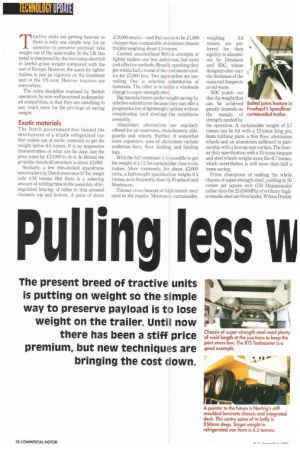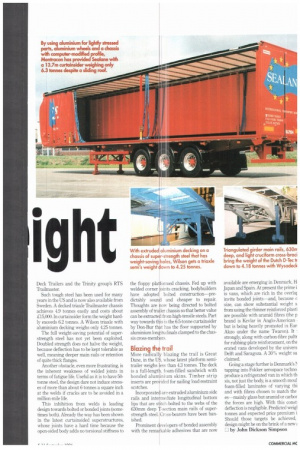Pu lling less
Page 40

Page 41

If you've noticed an error in this article please click here to report it so we can fix it.
Deck Trailers and the Trinity group's RTS Traihnaster.
Such tough steel has been used for many years in the US and is now also available from Sweden. A decked triaxle Trailmaster chassis achieves 4.9 tonnes easily and costs about £15,000. In curtainsider form the weight hardly exceeds 6.2 tonnes. A Wilson triaxle with aluminium decking weighs only 4.25 tonnes.
The full weight-saving potential of superstrength steel has not yet been exploited. Doubled strength does not halve the weight, because deflection has to be kept tolerable as well, meaning deeper main rails or retention of quite thick flanges.
Another obstacle, even more frustrating, is the inherent weakness of welded joints in terms of fatigue life. Useful as it is to have 50tonne steel, the design dare not induce stresses of more than about 6 tonnes a square inch at the welds if cracks are to be avoided in a million-mile life.
This inhibition from welds is leading design towards bolted or bonded joints (sometimes both). Already the way has been shown in the latest curtainsided superstructures, whose joints have a hard time because the open-sided body adds no torsional stiffness to
the floppy platiortned chassis. Fed up with welded corner joints cracking, bodybuilders have adopted bolted construction—predictably sound and cheaper to repair. Thoughts are now being directed to bolted assembly of trailer chassis so that better value can be extracted from high-tensile steels. Part way towards this is the 6.5-tonne curtainsider by Don-Bur that has the floor supported by aluminium longitudinals clamped to the chassis cross-members.
Blazing the trail
More radically blazing the trail is Great Dane, in the US, whose latest platform semitrailer weighs less than 4.3 tonnes. The deck is a full-length, foam-filled sandwich with bonded aluminium skins. Timber strip inserts are provided for nailing load-restraint scotches.
Incorporated are extruded aluminium side rails and intermediate longitudinal bottom lips that are stitch-bolted to the webs of the 630mm deep 1-section main rails of superstrength steel. Cross-bearers have been banished.
Prominent developers of bonded assembly with the remarkable adhesives that are now
available are emerging in Denmark, El Japan and Spain. At present the prime i is vans, which are rich in the overlai invite bonded joints—and, because c size, can show substantial weight s from using the thinner reinforced plasti are possible with aramid fibres (the p brand is Kevlar in Anglo-American but is being heavily promoted in Eur Akzo under the name Twaron). It strongly, along with carbon-fibre pultr for rubbing-plate reinforcement, on the erated vans developed by the univers Delft and Saragoza. A 30% weight sa claimed.
Going a stage further is Denmark's tapping into Fokker aerospace techno produce a refrigerated van in which th sis, not just the body, is a smooth moul foam-filled laminates of varying thi and with fibres chosen to match the es—mainly glass but aramid or carbor the forces are high. With this consti deflection is negligible. Predicted weigl tonnes and expected price premium i Should those targets be achieved, design might be on the brink of a new ; LI by John Dickson Simpson
















































































































